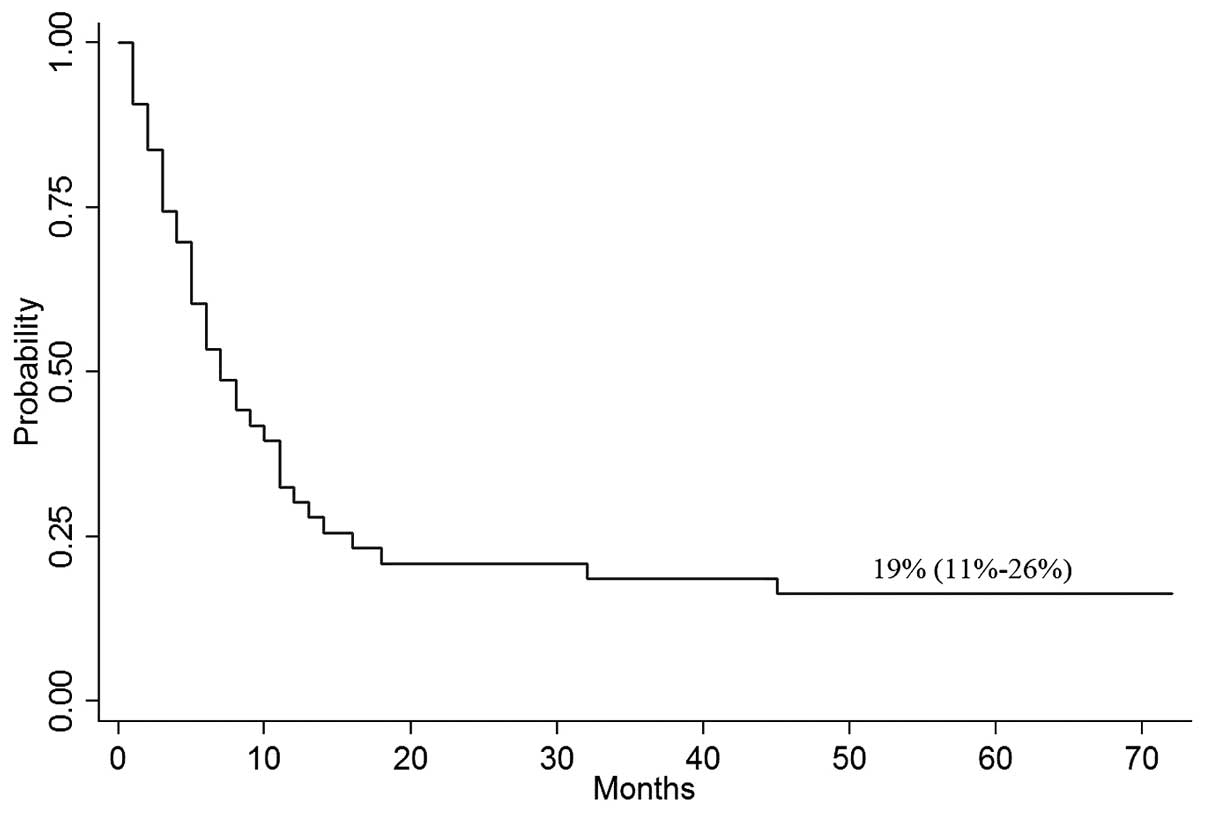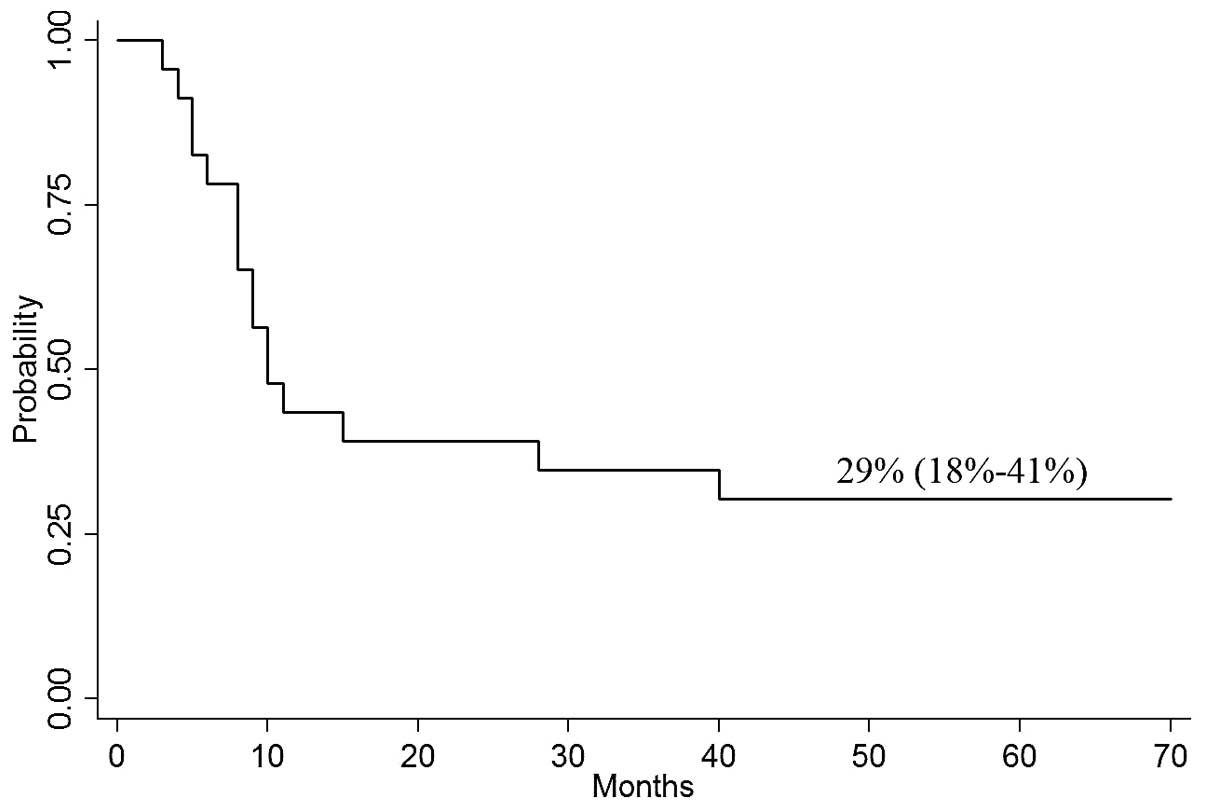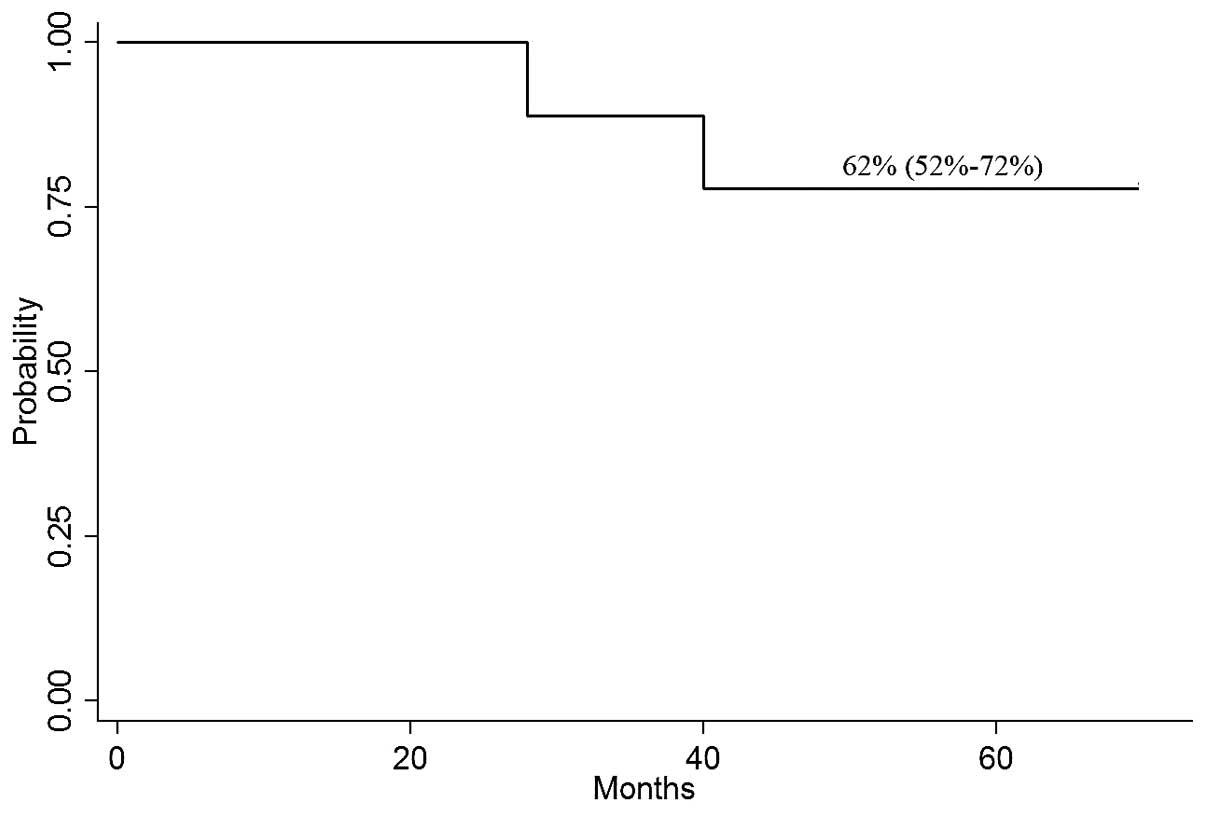Clinical study of Mito-FLAG regimen in treatment of relapsed acute myeloid leukemia
- Authors:
- Published online on: January 22, 2013 https://doi.org/10.3892/etm.2013.917
- Pages: 982-986
Abstract
Introduction
Despite the achievement of an initial complete remission (CR) in the majority of patients with acute myeloid leukemia (AML), the therapeutic results at present remain unsatisfactory. With one or two courses of standard first-line induction chemotherapy, 60–80% of patients with newly diagnosed AML achieve CR; however, 50–70% of them eventually relapse. The disease-free survival (DFS) rate and the overall survival (OS) rate remain low (1–2). Currently, there are no standard salvage regimens for relapsed AML; therefore, alternative treatments that produce improved outcomes for these patients should be explored.
Cytosine arabinoside (Ara-C) remains one of the most effective drugs in AML therapy (3). Fludarabine, a purine analog, markedly increases the intracellular accumulation of Ara-C triphosphate (Ara-CTP), the active metabolite of Ara-C (4). The combination of a middle dose of Ara-C along with fludarabine has also achieved a satisfactory CR rate in refractory or relapsed AML, from 47.5 to 64% (5,6). Adding another chemotherapeutic agent to the FLAG regimen has become one of the hot issues of study. A number of studies have reported on FLAG with mitoxantrone for treating patients with refractory or relapsed AML. The CR rates were 59 and 67%, respectively (7,8). However, to date there have been no reports of this regimen for relapsed AML solely. Since 2003, we have used fludarabine combined with a middle dose of Ara-C, mitoxantrone and granulocyte-colony stimulating factor (G-CSF) as a salvage regimen for patients with relapsed AML in China.
Patients and methods
Patients
Between December 2003 and March 2008, 45 patients (22 males, 23 females, aged 17–61 years, median 34 years) with relapsed AML were treated with the Mito-FLAG regimen after obtaining informed consent. These patients had received standard first-line induction chemotherapy following initial diagnosis. Hematologic relapse was defined by recurrence of >5% blasts in the bone marrow (BM). Diagnosis and classification of AML were performed according to the French-American-British (FAB) Corporation criteria (9). The clinical features of the patients are listed in Table I. The study was approved by the ethics committee of Wenzhou Medical College (Wenzhou, China).
Methods
The Mito-FLAG regimen consisted of five days of treatment with mitoxantrone (7 mg/m2, days 1, 3 and 5), fludarabine (30 mg/m2, days 1–5), Ara-C (1 g/m2, over 3 h every 12 h, days 1–5) and G-CSF [5 μg/kg/day subcutaneously from day 0 until the white blood count (WBC) was >20×109/l].
The response criteria were established according to revised recommendations of the International Working Group for Diagnosis, Standardization of Response Criteria, Treatment Outcomes and Reporting Standards for Therapeutic Trials in Acute Myeloid Leukemia (10). CR was defined as <5% BM blasts with a neutrophil count of >1.0×109/l, a platelet count of >100×109/l and no other diseases. Partial response (PR) was established as either 5–25% BM blasts, a ≥50% decrease in BM blasts or <5% BM blasts but with Auer rod presence. No remission (NR) was established for patients who did not fulfill the above criteria. BM aspirate was performed following chemotherapy as soon as the patient achieved peripheral blood morphology values required for CR; however, this was not performed later than 50 days from the start of treatment. Early mortality (EM) was defined as mortality from any cause during the first 30 days from the beginning of the Mito-FLAG therapy.
Patients in PR received another course of the same regimen. Patients in CR received allogeneic stem cell transplantation (allo-SCT) subsequently if aged <50 years with a suitable donor, whereas those without a donor received maintenance therapy. Antibiotic treatment and supportive care were administered according to local guidelines. Patients with treatment failures received another salvage chemotherapy regimen or palliation therapy subsequently. Hematological and extra-hematological toxicity were assessed according to the World Health Organization (WHO) criteria (11).
DFS was calculated from the first day of remission until the evidence of progression. OS was calculated from the start of Mito-FLAG regimen until mortality.
Statistical analysis
Statistical analysis was performed using the Chi-square test and Kaplan-Meier survival curves were produced. We considered a two-tailed P-value <0.05 to be an indication of statistical significance.
Results
Therapeutic effects
Out of the 45 patients, 21 (47%) achieved CR following the first course of Mito-FLAG and 5 (11%) achieved PR. All the patients with PR received second Mito-FLAG regimen and 2 patients achieved CR following the second course. Finally, CR and PR was achieved in 23 (51%) and 3 (7%) patients, respectively, so the overall response rate was 58%. Fifteen patients (33%) were refractory and 4 (9%) succumbed early due to cerebral hemorrhage (n=3) or pulmonary infection (n=1). Patients with abnormal karyotype (n=16, 36%) had a CR rate of 43.8% and patients with early relapse (n=25) and late relapse (n=20) had a CR rate of 40.0 and 65.0%, respectively. However, analysis of corresponding subgroups stratified according to karyotype and early/late relapse did not show significant differences (Table II).
Toxicity associated with Mito-FLAG regimen
Four patients (9%) succumbed early; three from cerebral hemorrhage (n=3) and one from pulmonary infection. As expected, severe myelosuppression was observed in all patients. Hematological toxicity and infections were the most prominent toxicities of the Mito-FLAG treatment. The median number of days to recovery of neutrophil count (>0.5×109/l) and platelet count (>20×109/l) was 19 days (range, 9–48 days) and 24 days (range, 10–95 days), respectively. Patients received a median of 5 units (range, 0–12 units) of suspended red cells and 5 units (range, 3–23 units) of apheresis platelets. The incidence of serious infections was high. All but 6 patients experienced fever (temperature >38°C) during the neutropenic phase. Twenty-one patients (47%) had confirmed grade III–IV infections (according to the WHO criteria), which included pneumonia (29%), sepsis (11%), enteritis (7%), perianal abscess (4%) and stomatitis (2%). The median duration of antibiotic therapy was 25 days (range, 15–76 days). The other WHO grade III–IV toxicities included nausea and vomiting (22%), bleeding (18%), hyperbilirubinemia (4%), renal toxicity (4%) and arrhythmia (2%). The median time of hospitalization was 46 days (range, 18–108 days).
Overall survival and disease-free survival
Two patients were lost to follow-up shortly after receiving induction chemotherapy. The median OS for the other 43 patients was 7 months. With a median follow-up of 11 months (95% CI, 1–72%), the probability of OS at 4 years was 19% (95% CI, 11–26%; Fig. 1). The median time of DFS for all 23 patients in CR was 10 months. The probability of 4-year DFS was 29% (95% CI, 18–41%; Fig. 2).
Post-transplant outcome
Out of the 23 patients in CR, 9 (20%) received allo-SCT. Among them, 2 patients received allo-SCT with a matched related donor and 7 patients with a matched unrelated donor. Two patients succumbed due to relapse. Seven patients remained in CR. The median OS time for the patients who underwent allo-SCT was 56 months. The probability of OS at 4 years was 62% (95% CI, 52–72%; Fig. 3).
Discussion
Ara-C is one of the most effective drugs in AML therapy (3). It performs antitumor effects by transforming into 5′-triphosphate Ara-C (Ara-CTP) in cells. A previous study suggested that patients benefit from high-dose therapy when an increase in intracellular Ara-CTP occurs with higher extracellular concentrations of Ara-C (12). Therefore, increased dosages of Ara-C to produce tumor remission rate improvement are often utilized doctors in the clinic. However, the dose escalation of Ara-C did not improve the outcome in practice (13). Thus, the main aim of current research is to determine how to increase the concentration of Ara-CTP in leukemic cells to overcome Ara-C resistance. Fludarabine, a purine analog, which is not susceptible to degradation by adenosine deaminase, maintains in vivo activity. By phosphorylation in the plasma, fludarabine transforms to lipophilic 2-F-Ara-ATP which easily passes through the membrane of tumor cells. Following phosphorylation by deoxycytidine kinase, 2-F-Ara-ATP turns to activated F-Ara-ATP, which inhibits the synthesis of DNA, RNA and protein. F-Ara-ATP increases the activity of deoxycytidine kinase, increasing the rate of Ara-CTP accumulation by 2–3 fold (14). Fludarabine, in addition to Ara-C, increases the concentration of Ara-CTP by almost 5 fold in the regimen of Ara-C and G-CSF (15). G-CSF mobilizes quiescent leukemic cells into the cell cycle and increases the sensitivity to Ara-C, the intake of Ara-C and Ara-C-induced apoptosis. G-CSF also enhances the activity of topoisomerase II and accelerates intracellular phosphorylation of fludarabine (16). The FLAG regimen is composed of fludarabine, Ara-C and G-CSF, which has achieved satisfactory CR rate in treating refractory or relapsed AML. The FLAG regimen is repeatedly described as a well-tolerated salvage regimen in AML with CR rates between 47.5 and 68% (5,18,19).
Adding another chemotherapeutic agent to the FLAG regimen has become one of the hot issues of study. A number of studies of FLAG along with idarubicin (IDA-FLAG regimen) for treating patients of refractory or relapsed AML have been reported. The CR rates were 42 and 52%, respectively, which were similar to FLAG (20,21). Mitoxantrone is one of the most common drugs in AML therapy, particularly in refractory or relapsed AML. Further studies indicated that doses of mitoxantrone, a topoisomerase II-directed drug, may be escalated far beyond the conventional dose schedule, with clinical benefit to patients with acute leukemia when combined with Ara-C. The effect is satisfactory and the tolerance is acceptable, even in elderly patients (7,22). FLAG combined with mitoxantrone strengthens the anti-leukemic activity. A number of studies of FLAG along with mitoxantrone for treating patients of refractory or relapsed AML have been reported. The CR rates were 59 and 67%, respectively (7,8).
In our study, the overall response rate was 58%, similar to that of IDA-FLAG. However, the price of idarubicin is more expensive than that of mitoxantrone in China. In addition, idarubicin has been used in the majority of patients with relapsed AML previously and reuse of idarubicin may result in serious cardiac toxicity and other toxicities. Therefore, Mito-FLAG was selected for relapsed AML in our study. Four patients (9%) succumbed early. Although hematological toxicity and infections were the most prominent toxicities of the Mito-FLAG treatment, the patients recovered quickly. The probability of OS at 4 years was 19% and the probability of 4-year DFS was 29% for all 23 patients in CR. Nine out of 23 patients in CR received allo-SCT and 7 of them remained in CR at the end of follow-up. These results indicate that the Mito-FLAG regimen is a highly effective and well-tolerated salvage regimen in relapsed AML. The toxicity is acceptable, enabling the majority of patients to receive further treatment including allo-SCT.
References
|
Löwenberg B, Downing JR and Burnett A: Acute myeloid leukemia. N Engl J Med. 341:1051–1062. 1999. | |
|
Estey E and Döhner H: Acute myeloid leukaemia. Lancet. 368:1894–1907. 2006. View Article : Google Scholar | |
|
Roboz GJ: Novel approaches to the treatment of acute myeloid leukemia. Hematology Am Soc Hematol Educ Program. 2011:43–50. 2011. View Article : Google Scholar : PubMed/NCBI | |
|
Gandhi V, Estey E, Keating MJ and Plunkett W: Biochemical modulation of arabinosylcytosine for therapy of leukemias. Leuk Lymphoma. 10:109–114. 1993. View Article : Google Scholar : PubMed/NCBI | |
|
Lee SR, Yang DH, Ahn JS, Kim YK, Lee JJ, Choi YJ, Shin HJ, Chung JS, Cho YY, Chae YS, Kim JG, Sohn SK and Kim HJ: The clinical outcome of FLAG chemotherapy without idarubicin in patients with relapsed or refractory acute myeloid leukemia. J Korean Med Sci. 24:498–503. 2009. View Article : Google Scholar : PubMed/NCBI | |
|
Ferrara F, Palmieri S, Pocali B, Pollio F, Viola A, Annunziata S, Sebastio L, Schiavone EM, Mele G, Gianfaldoni G and Leoni F: De novo acute myeloid leukemia with multilineage dysplasia: treatment results and prognostic evaluation from a series of 44 patients treated with fludarabine, cytarabine and G-CSF (FLAG). Eur J Haematol. 68:203–209. 2002. View Article : Google Scholar | |
|
Clavio M, Carrara P, Miglino M, Pierri I, Canepa L, Balleari E, Gatti AM, Cerri R, Celesti L, Vallebella E, Sessarego M, Patrone F, Ghio R, Damasio E and Gobbi M: High efficacy of fludarabine-containing therapy (FLAG-FLANG) in poor risk acute myeloid leukemia. Haematologica. 81:513–520. 1996.PubMed/NCBI | |
|
Hänel M, Friedrichsen K, Hänel A, Herbst R, Morgner A, Neser S, Nicklisch M, Teich M, Ehninger G and Fiedler F: Mito-flag as salvage therapy for relapsed and refractory acute myeloid leukemia. Onkologie. 24:356–360. 2001.PubMed/NCBI | |
|
Bennett JM, Catovsky D, Daniel MT, Flandrin G, Galton DA, Gralnick HR and Sultan C: Proposed revised criteria for the classification of acute myeloid leukemia. A report of the French-American-British Cooperative Group. Ann Intern Med. 103:620–625. 1985. View Article : Google Scholar : PubMed/NCBI | |
|
Cheson BD, Bennett JM, Kopecky KJ, Büchner T, Willman CL, Estey EH, Schiffer CA, Doehner H, Tallman MS, Lister TA, Lo-Coco F, Willemze R, Biondi A, Hiddemann W, Larson RA, Löwenberg B, Sanz MA, Head DR, Ohno R and Bloomfield CD: Revised recommendations of the International Working Group for Diagnosis, Standardization of Response Criteria, Treatment Outcomes and Reporting Standards for Therapeutic Trials in Acute Myeloid Leukemia. J Clin Oncol. 21:4642–4649. 2003. View Article : Google Scholar | |
|
Miller AB, Hoogstraten B, Staquet M and Winkler A: Reporting results of cancer treatment. Cancer. 47:207–214. 1981. View Article : Google Scholar : PubMed/NCBI | |
|
Rustum YM, Slocum HK, Wang G, Bakshi D, Kelly E, Buscaglia D, Wrzosek C, Early AP and Preisler H: Relationship between plasma Ara-C and intracellular Ara-CTP pools under conditions of continuous infusion and high-dose Ara-C treatment. Med Pediatr Oncol. 10(Suppl 1): 33–43. 1982. View Article : Google Scholar : PubMed/NCBI | |
|
Kern W and Estey EH: High-dose cytosine arabinoside in the treatment of acute myeloid leukemia: Review of three randomized trials. Cancer. 107:116–24. 2006. View Article : Google Scholar : PubMed/NCBI | |
|
Gandhi V, Estey E, Keating MJ and Plunkett W: Fludarabine potentiates metabolism of cytarabine in patients with acute myelogenous leukemia during therapy. J Clin Oncol. 11:116–124. 1993.PubMed/NCBI | |
|
Ossenkoppele GJ, Graveland WJ, Sonneveld P, Daenen SM, Biesma DH, Verdonck LF, Schaafsma MR, Westveer PH, Peters GJ, Noordhuis P, Muus P, Selleslag D, van der Holt B, Delforge M, Löwenberg B and Verhoef GE: The value of fludarabine in addition to ARA-C and G-CSF in the treatment of patients with high-risk myelodysplastic syndromes and AML in elderly patients. Blood. 103:2908–2913. 2004. View Article : Google Scholar : PubMed/NCBI | |
|
Hubeek I, Litvinova E, Peters GJ, Broekhuizen R, Haarman EG, Huismans DR, Cloos J, Zwaan CM, Fleischhack G, Creutzig U and Kaspers GJ: The effect of G-CSF on the in vitro cytotoxicity of cytarabine and fludarabine in the FLAG combination in pediatric acute myeloid leukemia. Int J Oncol. 25:1823–1829. 2004.PubMed/NCBI | |
|
Carella AM, Cascavilla N, Greco MM, Melillo L, Sajeva MR, Ladogana S, D’Arena G, Perla G and Carotenuto M: Treatment of “poor risk” acute myeloid leukemia with fludarabine, cytarabine and G-CSF (flag regimen): a single center study. Leuk Lymphoma. 40:295–303. 2001. | |
|
Wang SH, Yu L, Wang QS, Li HH, Zhao Y and Li F: Effects of FLAG protocol in treatment of the first time induced non-remission acute myeloid leukemia. Zhongguo Shi Yan Xue Ye Xue Za Zhi. 15:1297–1299. 2007.(In Chinese). | |
|
Yavuz S, Paydas S, Disel U and Sahin B: IDA-FLAG regimen for the therapy of primary refractory and relapse acute leukemia: a single-center experience. Am J Ther. 13:389–393. 2006. View Article : Google Scholar : PubMed/NCBI | |
|
Pastore D, Specchia G, Carluccio P, Liso A, Mestice A, Rizzi R, Greco G, Buquicchio C and Liso V: FLAG-IDA in the treatment of refractory/relapsed acute myeloid leukemia: single-center experience. Ann Hematol. 82:231–235. 2003.PubMed/NCBI | |
|
Feldman EJ, Seiter K, Damon L, Linker C, Rugo H, Ries C, Case DC Jr, Beer M and Ahmed T: A randomized trial of high- vs standard-dose mitoxantrone with cytarabine in elderly patients with acute myeloid leukemia. Leukemia. 11:485–489. 1997. View Article : Google Scholar : PubMed/NCBI | |
|
Feldman EJ, Alberts DS, Arlin Z, Ahmed T, Mittelman A, Baskind P, Peng YM, Baier M and Plezia P: Phase I clinical and pharmacokinetic evaluation of high-dose mitoxantrone in combination with cytarabine in patients with acute leukemia. J Clin Oncol. 11:2002–2009. 1993.PubMed/NCBI |












